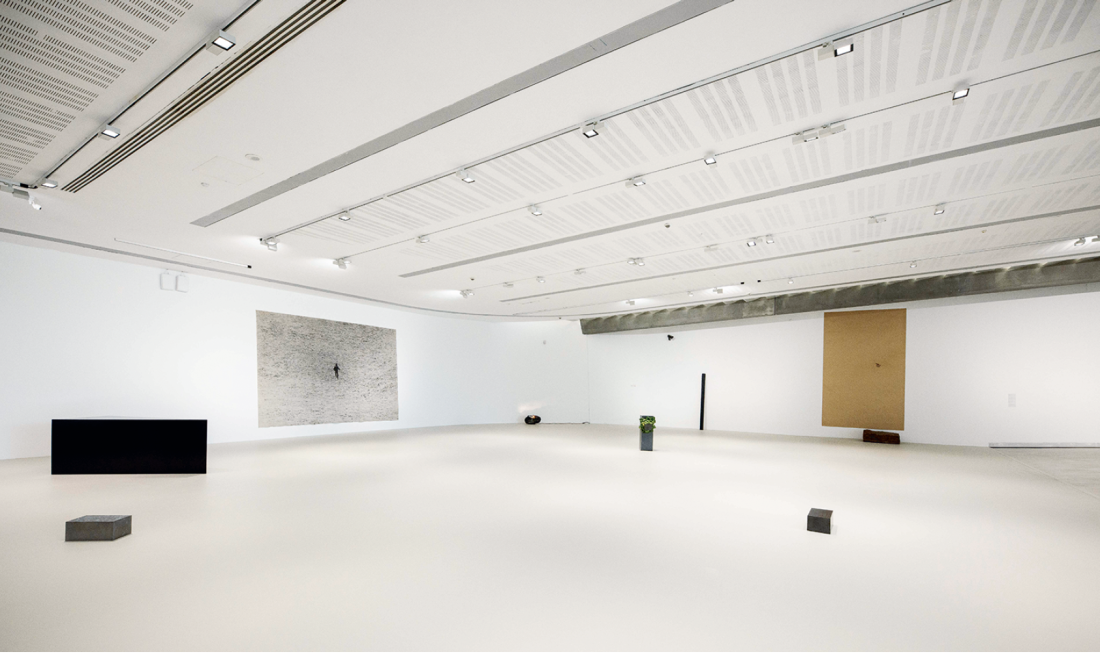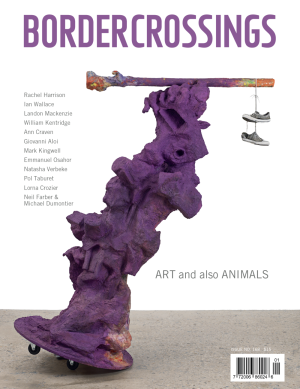Giovanni Anselmo
One of the unforgettable moments of my student years: a professor trying to guide us through the non-dualistic philosophy of the eighth-century Hindu thinker Śaṅkara, with its paradoxical idea of being. At the end of a long excursus, our professor finally concluded, “So ‘is’ is a metaphor!” (Later I realized that he probably unexpectedly hit on this formulation each time he taught the course.) I thought again of that mind-twister while visiting the presentation of Giovanni Anselmo’s retrospective at MAXXI in Rome, where it had travelled following its first appearance at the Guggenheim Bilbao earlier this year, where it had opened just a couple of months after the artist’s death at the age of 89 at the end of 2023. I understand why the exhibition’s curator, Gloria Moure, contends that Anselmo’s work consists of “the crude exhibition of objects and materials,” but I couldn’t reflect that in this art, all these empirically existing things become something else: they are metaphors—and I don’t just mean that they are used metaphorically but that their very being becomes metaphorical.
And it is as metaphors that the works become paradigmatic, which is to say that they function as models or patterns for a certain stance toward reality. Such exemplary patterns need be very few—amo, amas, amat is the only paradigm you need for the conjugation of a Latin singular verb—and the same for exemplary artworks: Anselmo, I believe, made and exhibited no more of them than was necessary to articulate his thought. This stark laconism has always been one of the most impressive aspects of his oeuvre, and the spare, lucid presentation in Rome was true to it.

Giovanni Anselmo, installation view, “Oltre l’orizzonte,” 2024, MAXXI, Rome. Exhibition by Guggenheim Museum Bilbao in collaboration with MAXXI. Photo: MUSA. © Giovanni Anselmo. Courtesy Archivio Giovanni Anselmo ETS, Turin. Image courtesy Fondazione MAXXI, Rome, and Marian Goodman Gallery, New York. Artwork: Mentre verso oltremare il colore solleva la pietra, 1995–2023, stones, steel cable, slipknot, Oltremare acrylic paint, dimensions vary.
This quality of being at once metaphorical and paradigmatic is evident in two of the earliest works on view, Senza titolo (Struttura che mangia) and Senza titolo (Struttura che beve), both from 1968. The former is a head of lettuce clasped between two granite blocks held together by wire. We immediately think of so many antitheses: soft and hard, organic and inorganic, ephemeral and durable … But we should also take note of the dialectic between apothegmatic gravity and lapidary wit, blunt force and incisive point. Anselmo’s ability to formulate his material propositions in the most concise manner reflects the flash of insight offered by humour, perhaps as embodied in koan-like form. This becomes particularly evident when the work directly incorporates language. In Invisibile, 1971, a slide bearing the word visibile, the Italian word for “visible” is projected toward an indefinite distance, and therefore the word, though passing through the space, becomes, in contradiction to the word but in accord with the work’s title, invisible—until someone happens to walk across its path and get captioned, as it were; the word and its passing support become temporarily visible after all. A similar projection uses the word particolare, which as an adjective means “particular” but as a noun means “detail.” If you cross the field of that projection, you get picked out as a specific entity but also reduced to a detail in a larger field, perhaps that of the totality, what a philosopher summed up as “everything that is the case.” Another work titled Invisibile, 1971–73, consists of two blocks of lead of different sizes with a space between them. Stamped into the top of the larger block, right next to the edge facing the smaller piece, is the word visibile. Apparently, the titular “in” might have appeared on the lead that should have filled in the empty space. In any case, it remains invisible.

Giovanni Anselmo, installation view, “Oltre l’orizzonte,” 2024, MAXXI, Rome. Exhibition by Guggenheim Museum Bilbao in collaboration with MAXXI. Photo: MUSA. © Giovanni Anselmo. Courtesy Archivio Giovanni Anselmo ETS, Turin. Image courtesy Fondazione MAXXI, Rome, and Marian Goodman Gallery, New York.
“Every force evolves a form,” to quote Guy Davenport, and Anselmo was always concerned that the form that any of his pieces took be visible evidence of the force of which it is the effect—the torsion or tension that arrived at an equilibrium. As an example, I offer Torsione, 1968. The artist’s own description will show why: “some skins are partially trapped in a concrete block and those that remain visible are twisted and hooked on a wooden stick. The stick is used to twist the skins and finally rests on the wall to prevent the twist from undoing as it rotates in the opposite direction.” The monumental stillness proper to sculpture represents not a static condition but an opposition of forces that are deadlocked. Its energy is latent.
The precise force of Anselmo’s oeuvre is probably related to the fact that it did not develop endlessly. He put forth a great number of resonant communiqués in the late 1960s and early ’70s, then formulated fewer and fewer new works as the years went on. Yet he did not simply repeat himself. Probably the most compelling new development of his later years was the use of stone slabs affixed to the wall as metaphors for painting. In L’aura della pittura, 1996, he uses the simple trick of applying paint to the top of blocks about seven and a half feet high—the paint can’t be seen, but its reflection on the white wall is visible. Matter becomes immaterial illumination, as good a description of art as any. ❚
“Giovanni Anselmo: Beyond the Horizon” was organized by Guggenheim Museum Bilbao and was on exhibition from February 9, 2024, to May 19, 2024. It then toured to MAXXI – National Museum of 21st Century Art, Rome, from June 20, 2024, to October 6, 2024.
Barry Schwabsky’s recent publications include a monograph, Gillian Carnegie (London: Lund Humphries, 2020), and the catalogue for the retrospective exhibition “Jeff Wall” at Glenstone Museum, 2021. His new collections of poetry are Feelings of And (New York: Black Square Editions, 2022) and Water from Another Source (New York: Spuyten Duyvil, 2023).

